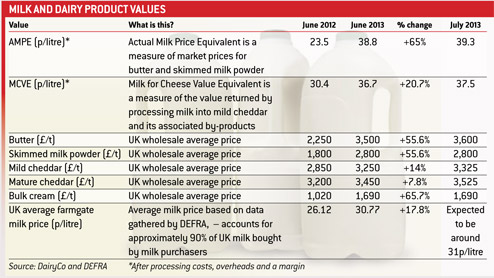ANALYSIS: The case for a higher milk price

Once again the UK dairy industry finds itself at a crossroads with average farmgate milk price wavering around the 31p/litre mark at a time of tight global supply and rising commodity values.
Yet an analysis of the market shows average farmgate milk prices are clearly behind where they should be given the improved performance of global dairy markets.
A quick glance at the dairy market over the past year (see table) shows a huge leap in the value of dairy products against a modest increase in farmgate milk price. In fact, DairyCo pointed out that the recent record average price of 30.77p/litre in June was only equal to the price paid to farmers in 1992, after accounting for UK inflation.

The lack of significant upward farmgate price movement in the past couple of months serves as a stark reminder that farmers on discretionary milk contracts can fall victim to UK supply chain limitations.
Historically, the UK market has been quick to drop prices when markets are weak but sluggish to react to market highs.
Processor consistency
Dairy companies often come under fire for using the market as justification for milk price lows – the 2p/litre cut in spring 2012 and proposed further 2p/litre cut sparked the SOS Dairy protests – but failing to up the price in line with market highs.
Last summer, the market for dairy commodities was the scapegoat, says NFU chief dairy adviser Rob Newbery, who points out actual milk price equivalent (AMPE) is now around 8p/litre higher than average farmgate milk prices and around 5p/litre ahead of the best retailer-aligned contract prices.
Dairy producer representatives are now building arguments on this basis for a price rise of between 1.5 and 2p/litre by 1 October. Milk price needs to reflect the appropriate value for milk, says Dairy Crest Direct secretary Michael Masters. Processors are on board, but they now need to get that extra money in the supply chain from their customers, he adds.
Tracking the market
The case for a farmgate price rise is bolstered by returns from formula contracts, which have come to the fore in the past six months. Both Dairy Crest and Muller Wiseman offer farmers the chance to have the value of some or all of their milk determined by market-based formulas.
Taking the Muller Wiseman formula contract as one indication of the “true value of milk”, average farmgate milk prices should certainly be higher.
The contract, which tracks AMPE, MCVE and a basket of competitor prices, has a milk price of 33.27p/litre for the three-month period between July and September, including a 1p/litre volume bonus – significantly ahead of the anticipated 31p/litre UK average farmgate price for July.
Competition for milk
UK processors continue to compete for farmers’ milk, with the lure of a higher price than their competitors, coupled with volume and recruitment incentives.
However, many of these incentives are short-term and lack clarity, warns NFU Scotland milk policy manager George Jamieson. Producers should be asking processors hard questions about company strategy and objective pricing mechanisms.
“Don’t be conned by an extra penny,” he warns. Paying attention to the detail of the contract is much more important.
Farmgate prices
Everything points towards a higher value for milk and the pressure is on processors to deliver a higher farmgate price. Failure to do so will result in further discontent and put the brakes on any farmer investment.
Although consultants forecast cost of production to be lower this winter, through lower feed costs and improved silage quality and quantity, processors must not hold back on delivering a price which reflects the true value of milk.
Global factors
- Value of dairy products remains high, with stable demand and relatively low stocks
- Increased EU and UK milk production not enough to compensate for earlier shortfall
- Dairy economics organisation IFCN price indicator puts world dairy prices close to 38 euro cents/kg or 32.5p/litre
- Irish Dairy Board index, which tracks actual product sales, indicates farmers should be receiving 38-40c/litre (34p/litre)
